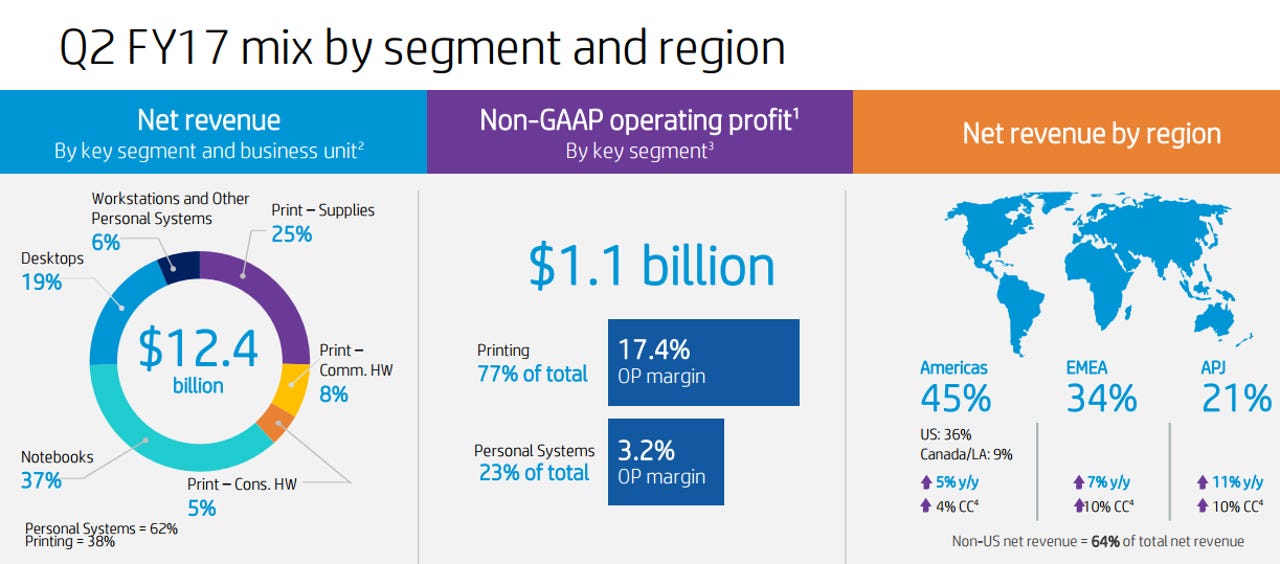HP hits its stride: How PCs and printing have stabilized, rebounded

When Hewlett Packard split its PC and printing business from its enterprise unit, it was widely assumed that Hewlett Packard Enterprise would outshine HP Inc. But better design and a knack for finding new profit pools in a tough personal systems market has put the spotlight on HP.
In its second quarter earnings report, HP reported revenue of $12.4 billion, up 7 percent from a year ago. Growth and the PC market are two terms that haven't gone together for a few years. HP also reclaimed the No. 1 spot in the PC market. HP's second quarter non-GAAP earnings of 40 cents a share were in line with the company's previous outlook.

How did HP get here? Some thoughts follow:
Focus
HP's PC and printer business was part of a much broader company and largely overshadowed. Before the split that created HP and HPE, the old HP had too many things to fix and too many battle fronts to manage. The split enabled the PC business to focus on the core product and design while entering new markets such as 3D printing. It's worth noting that HP has refocused on personal systems and printing just as Lenovo has expanded into the enterprise and mobile phones.
Strategy
HP has expanded its approach to personal systems and found more profit. CEO Dion Weisler outlined how HP is thinking about the $333 billion personal systems market. He said on a conference call:
If we take by way of example, the Personal Systems market, it's a $333 billion market but about half of that market is the non-core stuff that most of us think and talk about, Notebooks and Desktops and detachables and convertibles. The other half of the market is thin clients and services and accessories and displays, and in many of those markets we're underpenetrated. And in many of those markets,they come at higher margin. So as we index our way up into that part of the market, that helps offset the higher pressured areas of the core business.
Finding a way to make printing cool
The printing business was largely left for dead -- or at least a slow decline. But HP managed to deliver the first supplies growth in years. The printing division had revenue of $4.74 billion, up 2 percent from a year ago. HP has expanded its printer market with managed print services, instant ink subscriptions and 3D printing. Another callout was HP's Sprocket printer, which prints smartphone photos on the fly.
CFO Cathie Lesjak said:
Our total unit growth includes HP Sprocket, our handheld photo printer, which continued to have strong demand and contributed to our year-over-year metric. In calendar Q1, we gained share year-over-year in both our home and office businesses, with overall print share up 0.5 points.
What remains to be seen is whether HP can gain traction in 3D printing and additive manufacturing. HP has built out its channel for 3D printing, but seems behind the more industry-focused Stratasys. Ultimately HP's real fix may be to acquire Stratasys.
Read also: Stratasys demos 3D printing, additive manufacturing systems that take cues from data center | GE, Stratasys, SAP push 3D printing, additive manufacturing | New Stratasys 3D printers enable rapid prototyping from your workspace | Stratasys takes the next step in its software strategy
Design
HP has stepped up its PC design game and has segmented the market well. CNET reviews have noted the design point repeatedly in its reviews. Now Weisler noted that the PC market is volatile HP is operating well.
The two highest rated HP laptops are the Elitebook x360 and the Spectre x360.